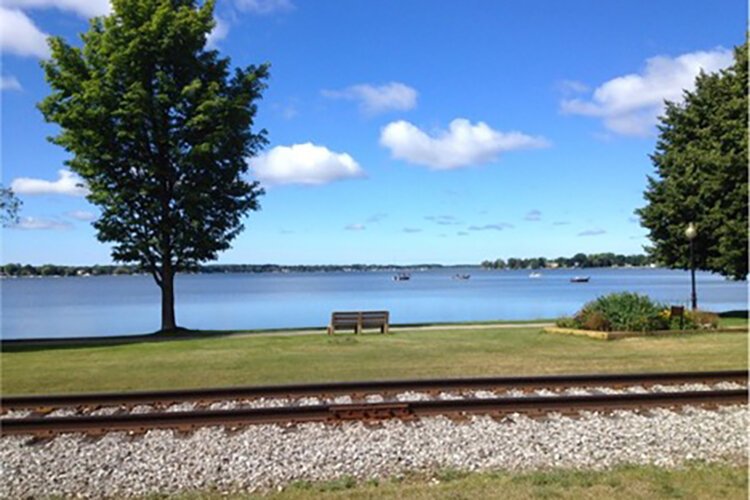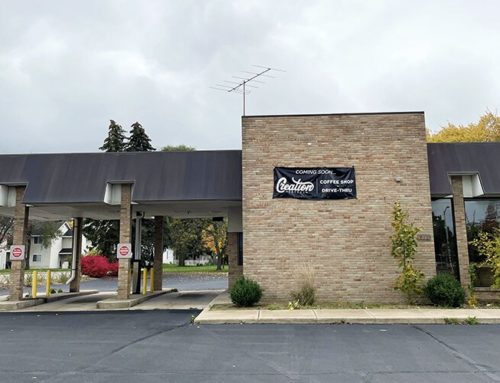Travel by train has the unique designation of being both a novelty of the past, as well as an innovation of the future. Images of steam locomotives merge with those of high-speed, shiny bullet trains. Whether it’s the nostalgia of times gone by that entices people or the efficiency of the travel method, people across the country have been using trains more frequently.
According to Amtrack’s Fiscal Year 2019 Report (the most recent year before the COVID-19 pandemic), ridership overall was up 2.5% compared to 2018. Additionally, their state report indicates, “At the end of FY19, there were 211,300 members of the Amtrak Guest Rewards program in Michigan. This is a 10% increase from FY18.”
As such, it should come as no surprise that Michiganders want to see train travel expand into Northern Michigan as well, and Groundwork – a nonprofit that works to create resilient communities in Michigan – is working to make that dream a reality.
“We’re not a train organization, but our mission is to create resilient communities,” says Carolyn Ulstad, Groundwork Transportation Program Manager. “This is just one way that we think communities can be more exciting to live in and be more resilient.”
To that end, Groundwork is moving forward on a project to implement a passenger line from Ann Arbor to Traverse City, stopping in towns such as Alma and Mt. Pleasant along the way.
“I’m excited about it because of the potential economic benefit from bringing people to downtown,” says Aaron Desentz, Mt. Pleasant City Manager. “Being on a line like that opens up some tourism opportunities that perhaps were overlooked in the past.”

 Cadillac, Michigan.
Cadillac, Michigan.
Ulstad says initial interest in this project started with the 2011 State Rail Plan. The plan states, “Passenger rail service also provides economic benefits to the state; there has been a steady increase in ridership on the Amtrak routes in Michigan over the past decade as more and more people are turning to the train as a transportation alternative for intercity trips.”
“When the state and MDOT were going through and doing their public engagements, like they do for any of their big plans, communities were asked about where they would like to see a future service. And no matter where they were holding these kinds of meetings, everyone pretty much said that they would like to see a connection going north into the Traverse City, Petoskey area,” she says. “Our office got wind of this and we were just really curious about what that would mean for communities further north.”
Jim Holton, owner of Mountain Town Station Restaurant and Brew Pub, which is housed in the renovated train station, is looking forward to the possibility of new travelers to the community utilizing the train. It is his hope that people from both groups will stop in to explore some of the smaller towns along the rail line that they haven’t seen before regardless of how long they plan to stay.
“Maybe they want to stop into a restaurant like mine, or a shop, or explore the community and stay the night,” he says.

 Downtown Mt. Pleasant, Michigan.
Downtown Mt. Pleasant, Michigan.
While it is still unknown where the train station would be located, Desentz says it would be somewhere with easy access to downtown, parking, and other amenities.
Not only could tourism benefit from the rail line going through Mt. Pleasant as people stop to shop, eat, use the park system, and golf, but it would also provide a key service for students and alumni of Central Michigan University.
“CMU has mentioned one of the challenges in their recruiting efforts has been convincing parents to send their children to what they might consider northern or rural Michigan because we don’t have as robust of a public transportation system,” says William Mrdeza, Community Services & Economic Development Director for Mt. Pleasant.
With a rail line going from Ann Arbor to Traverse City, through Mt. Pleasant, parents could visit easily, students would have an accessible method of transportation to go home, and alumni could easily attend homecoming events.
“I think there’s a lot of independence that students can have when there is a rail line,” Ulstad adds. “Another thing is that there’s a lot of international students at these colleges that come over and a rail line would make a huge difference to them, I believe, because a lot of international students are coming without a driver’s license typically, so that makes it more difficult to move around. But also, if you’re coming from another country, you probably have a general expectation of being able to move around easily without a car.”
Of course, there would also be numerous potential benefits for everyday residents of Mt. Pleasant. It would make travel throughout the state accessible for those without a driver’s license, those who aren’t comfortable driving in the winter, those with a disability that hinders their ability to drive long distances, etc.
With the abundant potential for tourism, business growth, and benefit to local citizens, Mrdeza says it has never taken much convincing for the city to be on board with the idea of the rail line coming through Mt. Pleasant.
“There has been continuous support not only by the commissioners since we were first approached about it by Groundwork in 2014 or 2015 but from citizens as well who have shown up at informative meetings,” he says.

 A track east of Traverse City receives updates.
A track east of Traverse City receives updates.
Ulstad says big projects such as getting a roughly 300-mile corridor of rail line safe for passengers – rather than freight – and working out the details of what that travel will look like takes time; however, Groundwork hopes to do an event train of some type this year, the details of which are yet to be determined. From there, she anticipates that services will evolve from occasional event trains to more frequent event trains, then move to weekend service, and eventually daily service. But, regular daily passenger service is several years away.
“To have the title – the official stamp – that it’s a daily service gets into the legality of how you need to define a passenger service through the Federal Railroad Administration,” she explains. “If you want to have regular daily service you have to have a whole other level of documentation and planning in place.”
Ulstad says one of the features that made this project feasible and pushed Groundwork to take it up was the fact that most of the Ann Arbor to Traverse City rail line is owned by the state.
“That’s a big deal because a lot of rail lines throughout the country and throughout Michigan have actually been bought up by freight rail companies,” she explains. “It’s just this unique thing that the State of Michigan still actually owns the majority of the portion of this track.”
“The tracks are there. It’s not just some concept where we’d have to cut down trees and build it or something like that; it’s already built. I think about how they’re used for freight at the moment, and the further north you get the frequency of shipments decreases. So, you have this incredible asset that’s just sitting there unused most of the time. It’s just sitting there. And I think it could have so much more value if we actually used it every day.”









